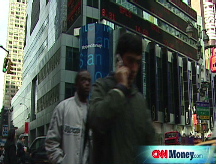Credit remains crunched
Lending rates fall slightly, but confidence gauges show anxiety remains in a volatile and troubled market.
NEW YORK (CNNMoney.com) -- With financial institutions and individual investors worried that a worldwide economic slowdown will pose a risk to their investments, lending remained constricted and U.S. Treasurys were mostly higher.
Despite efforts by global central banks to stimulate confidence in investors, markets continue to plunge, and anxiety still rules the day. In an attempt to encourage lending, central banks have lowered interest rates and directly injected capital into the banking system.
"The global crisis has taken on a life of its own," said Scott Anderson, senior economist with Wells Fargo. "The credit markets have a lot of problems now."
But help may be on the way. The Federal Reserve on Monday began to buy up large amounts of commercial paper, a key form of lending to major businesses and banks, in order to jumpstart the critical but faltering market.
To boost the $1.45 trillion market - which was about $2 trillion a year ago - the Fed is buying high-quality paper with a maturation period of three months. Some economists believe the Fed's efforts will restore confidence to the market and lower interest rates.
More rate cuts may be coming soon as well. According to the Chicago Board of Trade, investors now believe there is an 100% chance that the Federal Reserve will cut its key funds rate by as much as a half of a percentage point to stimulate the economy when it meets this week.
Lending: After edging up for two days in a row, the overnight Libor rate fell very slightly to 1.26% from 1.28% on Friday, according to Bloomberg.com. Short-term lending rates have been trending downwards for nearly two weeks. Libor is a daily average of what 16 different banks charge other banks to lend money in London.
Despite its recent rise, it still remains below the rate that federal banks charge other banks - which is generally viewed as an encouraging sign for the credit markets. The federal funds rate stands at 1.5%.
The 3-month Libor rate nudged lower to 3.51% from 3.52% on Friday, according to Dow Jones.
Longer-term rates have also been falling for two weeks, yet still remain much tighter than short-term lending rates. Investors fear that they'll end up holding debt for a company that won't be able to pay them back - or won't be there at all when the loan expires.
"We're starting to see the first signs of the credit markets healing," said Bill Larkin, portfolio manager at Cabot Money Management. "The market is self-correcting, and this is the first sign of a turn."
Market gauges: Even as rates fell, two key indicators of risk sentiment showed that confidence in the market was faltering slightly.
The "TED spread" rose to 2.76 percentage points from 2.67 points Friday. The TED spread measures the difference between the 3-month Libor and the 3-month Treasury bill, and is a key indicator of risk.
The higher the spread, the more unwilling investors are to take risks. The spread was 1.21 percentage points before the credit crisis and reached a record high of 4.65 points a little more than a week ago.
Another indicator, the Libor-OIS spread, moved higher to 2.63 percentage points from 2.61 points Friday.
The Libor-OIS spread measures how much cash is available for lending between banks, and is used for determining lending rates. The bigger the spread, the less cash is available for lending.
Treasurys rise: Government debt was mostly higher Monday as stocks ended the day lower. Turmoil in global stocks sent Treasurys higher, as investors sought more secure investments.
The benchmark 10-year note rose 3/32 to 102-20/32, and its yield fell to 3.68% from 3.72% late Friday. Bond prices and yields move in opposite directions.
The 30-year bond dipped 1/32 to 107 26/32, and its yield was 4.05%. In the previous session, the 30-year bond yield dipped below 3.90% for the first time since regular trading began in 1977.
With an influx of billions of dollars of fresh, short-term government debt to be auctioned this week, as well as a possible rate cut from by Federal Reserve Wednesday, shorter-term bonds had been lower all day.
Rate cuts tend to be inflationary, and bond investors worry that their assets will devalue over time as the dollar sinks.
The 2-year note rose 1/32 to 100-29/32, and its yield fell to 1.53% from 1.54% late Friday.
In order to finance its $750 billion financial rescue plan, the Treasury is set to auction off $34 billion in 2-year notes Tuesday. Investors were weary of buying up too much short-term debt with a huge amount of supply coming into the market.
But with market anxiety still mounting, the yield on the 3-month bill sank to 0.75%, down from 0.82% on Friday.
The yield on the 3-month Treasury bill is closely watched as an immediate reading on investor confidence. Investors and money-market funds shuffle funds into and out of the 3-month bill frequently, as they assess risk in the rest of the marketplace. A higher yield indicates that investors are slightly more optimistic. ![]()



